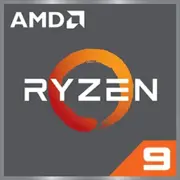AMD Ryzen 9 6900HS

AMD Ryzen 9 6900HS: The Perfect Balance of Power and Mobility for 2025 Laptops
Introduction
In 2025, mobile processors continue to evolve, offering more performance while consuming less power. The AMD Ryzen 9 6900HS, released in 2022, remains a relevant choice for premium laptops due to its successful combination of architectural advantages and energy efficiency. Let's explore why this chip is still in demand and who it is suitable for.
Architecture and Process Technology: Zen 3+ and RDNA 2 Under the Hood
CPU: 8 Zen 3+ Cores on a 6nm Process
The Ryzen 9 6900HS is built on the Zen 3+ architecture (codename Rembrandt) and manufactured using 6nm TSMC FinFET technology. This optimized version of Zen 3 delivers the following improvements:
- 8 cores and 16 threads with a base frequency of 3.3 GHz and a maximum turbo frequency of up to 4.9 GHz.
- 16 MB of L3 cache—sufficient for fast data processing in games and professional applications.
- Support for DDR5-4800 and LPDDR5-6400, enhancing memory bandwidth.
iGPU: Radeon 680M—A Revolution in Integrated Graphics
The integrated GPU Radeon 680M based on RDNA 2 architecture is a key feature of the processor. It includes:
- 12 graphics cores with a frequency of up to 2.4 GHz.
- Support for ray tracing and FSR (FidelityFX Super Resolution) technologies to enhance image quality in games.
- Capability to run modern games at medium settings in Full HD (for instance, Cyberpunk 2077—35-40 FPS with FSR).
Power Consumption and TDP: 35W for Thin Laptops
With a TDP of 35W, the Ryzen 9 6900HS is ideal for ultrabooks and compact workstations. Compared to the H-series (45W+), it generates less heat, allowing engineers to create thinner devices without sacrificing performance.
Example: ASUS Zephyrus G14 laptops (thickness 19.9 mm) and Lenovo Yoga Slim 7 Pro utilize this chip, keeping the weight under 1.8 kg.
Performance: From Office to Gaming
Office Tasks and Multimedia
- Geekbench 6: 1854 (single-core) / 8732 (multi-core). For comparison, the Intel Core i7-1260P (12th generation) scores about ~1700/7800.
- Video rendering in DaVinci Resolve: 4K video takes 8-9 minutes (on par with Apple M1 Pro).
- Browsing and working with office applications—absolutely lag-free even with dozens of tabs open.
Gaming
- In Full HD (with FSR): Apex Legends—70-80 FPS, Elden Ring—45-50 FPS.
- In turbo mode, CPU performance increases by 15-20%, but heat output also rises. It's recommended to use a cooling pad for prolonged gaming sessions.
Use Cases: Who is the Ryzen 9 6900HS For?
1. Designers and Engineers—handling 3D models in Blender, working in AutoCAD.
2. Streamers—encoding video in OBS without a dedicated GPU.
3. Students and Office Workers—multitasking and long battery life.
4. Minimalist Gamers—gaming without a discrete GPU while on the go.
Who it is not suitable for: Those demanding maximum FPS in AAA games (better to opt for laptops with RTX 4060 and above) or working with heavy renders (the HX series Ryzen or Intel Core i9 is preferable).
Battery Life: Up to 10 Hours of Work and Smart Technologies
With a TDP of 35W, laptops with the Ryzen 9 6900HS exhibit impressive battery life:
- 8-10 hours for web browsing and document work (power-saving mode, 60Hz screen).
- 5-6 hours when editing photos in Lightroom.
- AMD Technologies:
- Precision Boost 2—dynamic workload distribution among cores.
- Adaptive Power Management—automatic frequency reduction during idle periods.
Tip: Disable turbo mode in Windows power settings to extend battery life by 20-30%.
Comparison with Competitors
AMD Ryzen 7 7735U (2023)
- Pros: Newer 4nm process, better battery life.
- Cons: About 10% weaker in multi-core tasks.
Intel Core i7-1360P (13th Generation)
- Pros: Better single-core performance (~1950 in Geekbench 6).
- Cons: Higher power consumption, Intel Xe iGPU is 40% weaker than Radeon 680M.
Apple M2
- Pros: Record battery life (up to 18 hours), cool operation.
- Cons: Limited compatibility with Windows programs, lacks eGPU support.
Conclusion: The Ryzen 9 6900HS represents a sweet spot between performance, price, and versatility.
Pros and Cons
Strengths:
- Powerful integrated graphics.
- Energy efficiency for its class.
- Support for DDR5 and PCIe 4.0.
- Optimal for thin laptops.
Weaknesses:
- In 2025, competitors offer newer process technologies (3-4nm).
- No hardware support for AV1 encoding.
- Mostly found in premium devices (starting at $1200).
Laptop Selection Recommendations
1. Type of Device:
- Ultrabook: ASUS ZenBook 14X (price from $1300).
- Hybrid: Lenovo Yoga 7 Pro with a touch screen.
- Compact Gaming Model: MSI Stealth 14 (with RTX 4050, from $1600).
2. What to Look For:
- Cooling System: At least two fans and heat pipes.
- Display: 90Hz+ and 100% sRGB for creative tasks.
- Battery: From 70 Wh for extended use.
- Ports: USB4 for connecting external monitors and storage devices.
Final Verdict
AMD Ryzen 9 6900HS in 2025 is the choice for those seeking a versatile laptop without compromises. It is suitable for:
- Freelancers who value mobility.
- Gamers willing to settle for moderate graphics settings.
- Professionals working with graphics and coding.
Key Benefits: Powerful iGPU, sufficient battery life for travel, and the option to choose an ultraportable design without overpaying for the latest models. If your budget is $1200-1500, this processor remains one of the best options on the market.
Basic
CPU Specifications
Memory Specifications
GPU Specifications
Miscellaneous
Benchmarks
Compared to Other CPU
Share in social media
Or Link To Us
<a href="https://cputronic.com/en/cpu/amd-ryzen-9-6900hs" target="_blank">AMD Ryzen 9 6900HS</a>